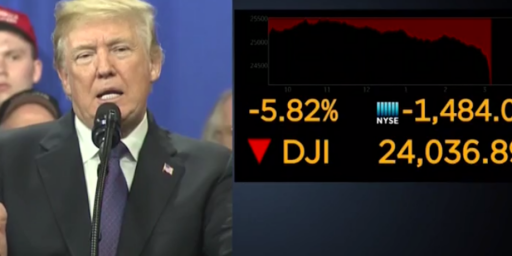Does the Housing Market Matter?
The recent turmoil on Wall Street has been linked to turmoil in the housing market, namely the serious problems in the subprime market. Over at Tech Central Station, Desmond Lachman argues why people who ignore the housing markets potential impact on the economy do so at their own risk.
Wall Street optimists minimize the bursting of the housing market bubble by emphasizing that residential construction accounts for a mere 6 percent of the overall US economy. This observation leads them to contend that even were home construction to decline by 20 percent over the next year, it would not shave much more than 1 percentage point off overall US economic growth. And with the rest of the US economy still in fine shape, they happily conclude that there is every reason to expect that the US economy will still continue to expand at a perfectly respectable 2.5 percent rate over the next twelve months.
In maintaining their rosy economic outlook, most Wall Street analysts choose to ignore Fed Chairman Ben Bernanke’s recent reminder that a protracted decline in home prices could have a material impact on consumer spending. According to Mr. Bernanke’s congressional testimony last week, the Federal Reserve estimates that household consumption could be negatively impacted by as much as 9 cents for every dollar that home prices decline on a sustained basis.
To the extent that wealth is a factor in consumer expenditures then any hit to that wealth will have a negative impact on consumer expenditures which is a major component of GDP.
Perhaps an even greater overlooked risk to the US economy than slowing consumer expenditure is the prospect of a full blown “credit crunch” in the financial sector that would seriously curtail bank lending to the economy as a whole. Sadly, this prospect too now seems to becoming an ever increasing likelihood. In his congressional testimony last week, Chairman Ben Bernanke owned up to the very real possibility that the financial sector’s losses from sub-prime mortgage lending could very well reach as much as US$100 billion.
The Federal Reserve and its European counterpart do seem to see this as a very real possibility. Today the Fed injected additional money into the U.S. financial system.
WASHINGTON (AP) — The Federal Reserve, trying to calm turmoil on Wall Street, announced Friday that it will pump as much money as needed into the U.S. financial system to help overcome the ill effects of a spreading credit crunch.
The Fed, in a short statement, said it will provide “reserves as necessary” to help the markets safely make their way. The central bank did not provide details but said it would do all it can to “facilitate the orderly functioning of financial markets.”
The Fed pushed $38 billion in temporary reserves into the system Friday, on top of a similar move the day before.
Financial markets in the United States and around the globe have been shaken by fears about spreading credit problems that started with home mortgages for those with tarnished credit histories. Investors are worried that these problems will infect the larger financial system and possibly hurt the U.S. economy.
[…]
The Fed’s action comes one day after a financial panic about a credit crunch swept through Europe. That prompted the Europeans to pump $130 billion into their financial system. The Fed moved Thursday to add an extra $24 billion in temporary reserves to the U.S. banking system. But that wasn’t enough to comfort Wall Street, which suffered its second-worst decline of the year that day.
And keep in mind that out of the 10 recessions since WWII, eight of them started in the real estate/housing sector according the Edward Leamer, head of UCLA’s Anderson Forecasting Center.
Update: Countrywide, the nations largest mortgage lender, “calls debt market chaos unprecedented“.
Countrywide Financial Corp. today said the market for debt it needs to fund itself is experiencing “unprecedented disruptions” that could impact its future profits and financial condition.
In its second-quarter filing with the SEC, the lender said there is less liquidity in the debt market and greater “risk premiums.” I imagine Countrywide means it may have to pay higher yields on its own debt or produce more collateral, or both. Anyway, the lender said it needs to maintain investment-grade ratings on its debt, and that is not a sure thing.





The S&L Crisis of the late ’80s was estimated to have cost $150B. How would this compare to that?
I have to agree with Charles, I guess I don’t see how that compares either. Great post, by the way!
I don’t know much about the S&L crisis but it did happen in the early 1980s when there were two recession around that time, so it maybe one of the 8 cases Leamer referenced.